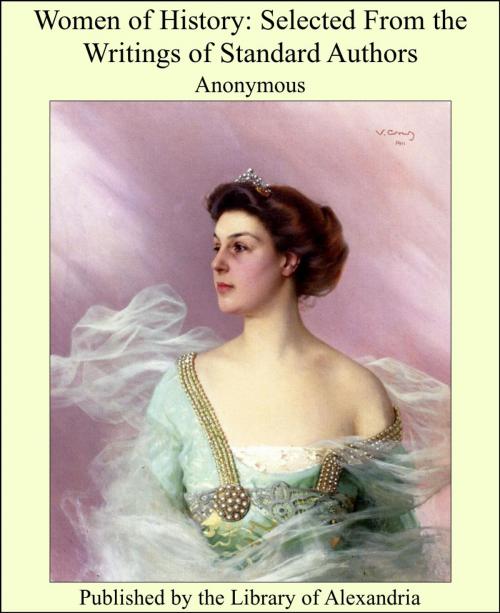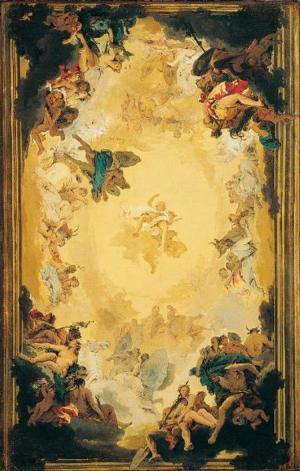Women of History: Selected From the Writings of Standard Authors
Nonfiction, Religion & Spirituality, New Age, History, Fiction & Literature| Author: | Anonymous | ISBN: | 9781465528568 |
| Publisher: | Library of Alexandria | Publication: | March 8, 2015 |
| Imprint: | Language: | English |
| Author: | Anonymous |
| ISBN: | 9781465528568 |
| Publisher: | Library of Alexandria |
| Publication: | March 8, 2015 |
| Imprint: | |
| Language: | English |
SAPPHO. [B.C. 568.] MURE. ACCORDING to established data, the more brilliant portion of Sappho's career may be placed in the first half of the sixth century before Christ, while her childhood and early youth belong to the close of the seventh. Her birthplace, according to the more trustworthy authorities, was Mitylene, the metropolis of the isle of Lesbos. Others make her a native of the neighbouring town of Eresus. Whether Sappho was ever married is doubtful; but the balance of evidence is strongly on the negative side of the question. She is familiarly alluded to by Horace as the "Lesbian maiden;" nor is there any notice of a husband, but on a single recent and very questionable authority, where the broadly indecent etymology of the names, both of the man on whom the honour is conferred, and of his birthplace, sufficiently proves them to be fictitious. How far the circumstance of her having had a daughter can be considered as admissible evidence of her having been married, is a point the settlement of which must depend on a closer inquiry into her moral habits. That such was the fact, however, is stated on respectable authority. The name assigned to the maiden is Cleis, the same as that of Sappho's reputed mOther. Sappho is described, by the only authors who have transmitted any distinct notices on the subject, as not distinguished for personal beauty, but as short of stature, and of dark, it may be understood swarthy, complexion. The laudatory commonplace of kalë, or "fair," which Plato and Others incidentally connect with her name, no way militates against this account, as implying nothing more, perhaps less, than does the English phrase by which the Greek epithet has above been rendered, and which is as frequently bestowed in familiar usage on plain as on handsome women. Alcæus describes her simply as "dark haired" and "sweetly smiling." No notice is taken of her actual beauty, which an admiring lover would hardly have passed over in silence had it offered matter for warmer eulogy. Of the extent to which Sappho was brought under the sway of the tender passion which, in one shape or Other, formed the theme, with little exception, of her collective works, sufficient evidence exists in her only remaining entire composition, the first ode in the published collections. She there describes herself, in the most touching and impassioned strains, as the victim of an unrequited love, and implores the aid of Venus to ease her pangs by melting the heart of the obdurate or inconstant object of her affection. The person to whom this ode is supposed to refer, or who at least obtained, in the popular tradition, the chief and longest sway over the affections of Sappho, was a Lesbian youth called Phaon, distinguished for his personal attractions and irresistible power over the female heart. For a time he is described as having corresponded to her ardour; but, after cohabiting with her during some years, he deserted her, leaving her in a state of despair, for which the only remedy that suggested itself was that habitually resorted to in such cases—a leap from the summit of the Leucadian promontory into the sea. That she actually carried this purpose into effect was the popular opinion of antiquity, from the age, at least, of Menander downwards, and seems to have passed current as an authentic fact, even with the more intelligent authorities. Both these points in the history of the poetess, her love for Phaon, and her leap from the Leucadian cliff, have been questioned with more or less plausibility by distinguished critics of the present age. In respect to the first, it has been denied not only that Phaon was the name of the hero of this tragical drama, but that such a person ever existed. The Leucadian leap of Sappho, though ranked by various modern commentators, like the name of her lover, among the mythical elements of her biography, will not perhaps be found, on a critical estimate of the circumstances connected with it, to offer any serious ground of scepticism
SAPPHO. [B.C. 568.] MURE. ACCORDING to established data, the more brilliant portion of Sappho's career may be placed in the first half of the sixth century before Christ, while her childhood and early youth belong to the close of the seventh. Her birthplace, according to the more trustworthy authorities, was Mitylene, the metropolis of the isle of Lesbos. Others make her a native of the neighbouring town of Eresus. Whether Sappho was ever married is doubtful; but the balance of evidence is strongly on the negative side of the question. She is familiarly alluded to by Horace as the "Lesbian maiden;" nor is there any notice of a husband, but on a single recent and very questionable authority, where the broadly indecent etymology of the names, both of the man on whom the honour is conferred, and of his birthplace, sufficiently proves them to be fictitious. How far the circumstance of her having had a daughter can be considered as admissible evidence of her having been married, is a point the settlement of which must depend on a closer inquiry into her moral habits. That such was the fact, however, is stated on respectable authority. The name assigned to the maiden is Cleis, the same as that of Sappho's reputed mOther. Sappho is described, by the only authors who have transmitted any distinct notices on the subject, as not distinguished for personal beauty, but as short of stature, and of dark, it may be understood swarthy, complexion. The laudatory commonplace of kalë, or "fair," which Plato and Others incidentally connect with her name, no way militates against this account, as implying nothing more, perhaps less, than does the English phrase by which the Greek epithet has above been rendered, and which is as frequently bestowed in familiar usage on plain as on handsome women. Alcæus describes her simply as "dark haired" and "sweetly smiling." No notice is taken of her actual beauty, which an admiring lover would hardly have passed over in silence had it offered matter for warmer eulogy. Of the extent to which Sappho was brought under the sway of the tender passion which, in one shape or Other, formed the theme, with little exception, of her collective works, sufficient evidence exists in her only remaining entire composition, the first ode in the published collections. She there describes herself, in the most touching and impassioned strains, as the victim of an unrequited love, and implores the aid of Venus to ease her pangs by melting the heart of the obdurate or inconstant object of her affection. The person to whom this ode is supposed to refer, or who at least obtained, in the popular tradition, the chief and longest sway over the affections of Sappho, was a Lesbian youth called Phaon, distinguished for his personal attractions and irresistible power over the female heart. For a time he is described as having corresponded to her ardour; but, after cohabiting with her during some years, he deserted her, leaving her in a state of despair, for which the only remedy that suggested itself was that habitually resorted to in such cases—a leap from the summit of the Leucadian promontory into the sea. That she actually carried this purpose into effect was the popular opinion of antiquity, from the age, at least, of Menander downwards, and seems to have passed current as an authentic fact, even with the more intelligent authorities. Both these points in the history of the poetess, her love for Phaon, and her leap from the Leucadian cliff, have been questioned with more or less plausibility by distinguished critics of the present age. In respect to the first, it has been denied not only that Phaon was the name of the hero of this tragical drama, but that such a person ever existed. The Leucadian leap of Sappho, though ranked by various modern commentators, like the name of her lover, among the mythical elements of her biography, will not perhaps be found, on a critical estimate of the circumstances connected with it, to offer any serious ground of scepticism















